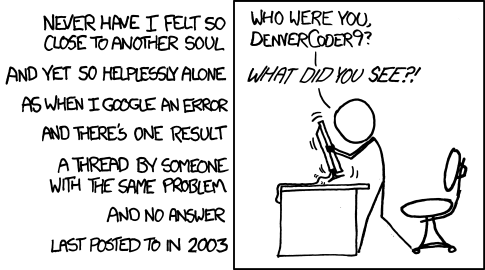Dear R-users
I use nnet for a classification (2 classes) problem. I use the code
CVnn1, CVnn2 as described in V&R.
The thing I changed to the code is: I define the (class) weight for each
observation in each cv 'bag' and give the vector of weights as parameter
of nnet(..weights = weight.vector...)
Unfortunately I get an error during some (but not all!) inner-fold cv runs:
Error in model.frame(formula, rownames, variables, varnames,
extras, extranames, :
variable lengths differ
If you just remove the weights parameter in nnet() it runs fine!!
I debugged the code but could not resolve the problem- it is really very
strange and I need your help! I tried it very simple in defining the
weights as = 1 for each obs (as it is by default)!:
CVnn2 <- function(formula, data,
size = c(0,4,4,10,10), lambda = c(0, rep(c(0.001,
0.01),2)),
nreps = 1, nifold = 5, verbose = 99, ...)
{
resmatrix <- function(predict.matrix, learn, data, ri, i)
{
rae.matrix <- predict.matrix
rae.matrix[,] <- 0
rae.vector <- as.numeric(as.factor((predict(learn, data[ri == i,],
type = "class"))))
for (k in 1:dim(rae.matrix)[1]) {
if (rae.vector[k] == 1)
rae.matrix[k,1] <- rae.matrix[k,1] + 1
else
rae.matrix[k,2] <- rae.matrix[k,2] + 1
}
rae.matrix
}
CVnn1 <- function(formula, data, nreps=1, ri, verbose, ...)
{
totalerror <- 0
truth <- data[,deparse(formula[[2]])]
res <- matrix(0, nrow(data), length(levels(truth)))
if(verbose > 20) cat(" inner fold")
for (i in sort(unique(ri))) {
if(verbose > 20) cat(" ", i, sep="")
data.training <- data[ri != i,]$GROUP
weight.vector <- rep(1, dim(data[ri !=i,])[1])
for(rep in 1:nreps) {
learn <- nnet(formula, data[ri !=i,],
weights = weight.vector,
trace = F, ...)
#res[ri == i,] <- res[ri == i,] + predict(learn,
data[ri == i,])
res[ri == i,] <- res[ri == i,] + resmatrix(res[ri == i,],
learn, data,
ri, i)
}
}
if(verbose > 20) cat("\n")
sum(as.numeric(truth) != max.col(res/nreps))
}
truth <- data[,deparse(formula[[2]])]
res <- matrix(0, nrow(data), length(levels(truth)))
choice <- numeric(length(lambda))
for (i in sort(unique(rand))) {
if(verbose > 0) cat("fold ", i,"\n",
sep="")
set.seed(i*i)
ri <- sample(nifold, sum(rand!=i), replace=T)
for(j in seq(along=lambda)) {
if(verbose > 10)
cat(" size =", size[j], "decay =",
lambda[j], "\n")
choice[j] <- CVnn1(formula, data[rand != i,], nreps=nreps,
ri=ri, size=size[j], decay=lambda[j],
verbose=verbose, ...)
}
decay <- lambda[which.is.max(-choice)]
csize <- size[which.is.max(-choice)]
if(verbose > 5) cat(" #errors:", choice, " ")
#
if(verbose > 1) cat("chosen size = ", csize,
" decay = ", decay, "\n",
sep="")
for(rep in 1:nreps) {
data.training <- data[rand != i,]$GROUP
weight.vector <- rep(1, dim(data[rand !=i,])[1])
learn <- nnet(formula, data[rand != i,],
weights = weight.vector,
trace=F,
size=csize, decay=decay, ...)
#res[rand == i,] <- res[rand == i,] + predict(learn,
data[rand == i,])
res[rand == i,] <- res[rand == i,] + resmatrix(res[rand ==
i,],learn,data, rand, i)
}
}
factor(levels(truth)[max.col(res/nreps)], levels = levels(truth))
}
res.nn2 <- CVnn2(GROUP ~ ., rae.data.subsetted1, skip = T, maxit = 500,
nreps = cv.repeat)
con(true = rae.data.subsetted$GROUP, predicted = res.nn2)
###
Coordinates:
platform i686-pc-linux-gnu
arch i686
os linux-gnu
system i686, linux-gnu
status
major 1
minor 9.1
year 2004
month 06
day 21
language R
########
Thanks a lot
Best regards
Christoph
--
Christoph Lehmann Phone: ++41 31 930 93 83
Department of Psychiatric Neurophysiology Mobile: ++41 76 570 28 00
University Hospital of Clinical Psychiatry Fax: ++41 31 930 99 61
Waldau lehmann at puk.unibe.ch
CH-3000 Bern 60 http://www.puk.unibe.ch/cl/pn_ni_cv_cl_03.html
